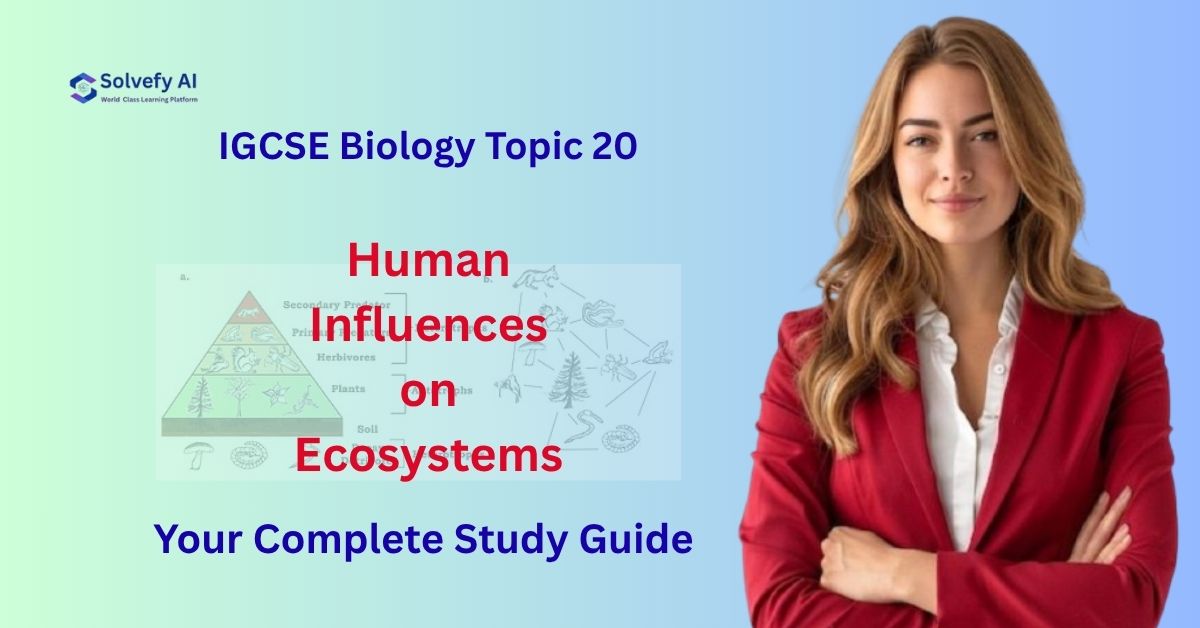Why Your Actions Matter More Than You Think
Have you ever wondered why your teachers keep talking about recycling, or why there’s so much fuss about plastic bags? Here’s something that might surprise you: every single action you take-from the breakfast you eat to the way you get to school-has an impact on our planet’s ecosystems. And understanding these connections isn’t just about passing your IGCSE exam (though we’ll definitely help you ace that!); it’s about understanding your role in the biggest story of our time.
Think about this: there are nearly 8 billion humans on Earth right now. That’s 8 billion people needing food, water, shelter, and energy. Now imagine the collective impact of all those needs. That’s what Topic 20 is all about-understanding how we, as a species, influence the delicate balance of life on Earth, and more importantly, what we can do about it.
This guide will walk you through everything you need to know for your IGCSE Biology exam, but it’ll also help you see the world differently. Let’s dive in!
Understanding the Basics: What Are Human Influences on Ecosystems?
Before we jump into the details, let’s establish what we mean by “human influences.” Simply put, these are any changes to the natural environment caused by human activities. These influences can be:
Negative impacts:
- Pollution (air, water, land)
- Habitat destruction
- Overexploitation of resources
- Introduction of invasive species
- Climate change
Positive impacts:
- Conservation efforts
- Habitat restoration
- Sustainable resource management
- Pollution control measures
- Protected areas and wildlife reserves
The key thing to remember is that humans have become such a dominant force on Earth that scientists have proposed we’re living in a new geological epoch called the “Anthropocene”-literally, the “Age of Humans.”
The Growing Human Population: The Root of the Problem
Why Population Matters
Let’s start with some eye-opening numbers. In 1800, the global human population was about 1 billion. By 1927, it doubled to 2 billion. By 1974, it doubled again to 4 billion. Today, we’re at nearly 8 billion, and projections suggest we’ll reach 10 billion by 2050.
Key factors driving population growth:
- Improved healthcare and medicine
- Better food production and distribution
- Reduced infant mortality rates
- Increased life expectancy
- Better sanitation and hygiene
The Consequences of Population Growth
More people means:
- Increased demand for food → More agricultural land needed
- Greater energy consumption → More fossil fuel burning
- More waste production → Pollution increases
- Expansion of cities → Natural habitats destroyed
- Higher water demand → Water scarcity issues
Memory Tip: Remember “FEDWW” – Food, Energy, Destruction, Waste, Water. These are the five main pressures from population growth!
Deforestation: When We Cut Down Our Life Support System
What Is Deforestation?
Deforestation is the permanent removal of trees and forests to make way for other land uses. It’s happening at an alarming rate-we’re losing about 10 million hectares of forest every year (that’s roughly the size of Iceland!).
Main causes of deforestation:
- Agricultural expansion: Clearing land for crops and livestock
- Logging: Harvesting timber for wood products
- Urban development: Building cities, roads, and infrastructure
- Mining operations: Extracting minerals and resources
- Fuel wood collection: Particularly in developing countries
The Devastating Effects of Deforestation
Let’s break down why losing forests is such a big deal:
1. Loss of Biodiversity
- Forests are home to 80% of terrestrial species
- When habitats disappear, species become extinct
- We lose potential sources of medicines and genetic diversity
2. Climate Change Acceleration
- Trees absorb CO₂ through photosynthesis
- Fewer trees = more CO₂ in atmosphere
- Burning forests releases stored carbon immediately
- Contributes significantly to greenhouse gas emissions
3. Soil Degradation
- Tree roots hold soil in place
- Without trees, topsoil erodes quickly
- Nutrients wash away
- Land becomes infertile and prone to desertification
4. Disruption of Water Cycles
- Trees play a crucial role in the water cycle
- They absorb water and release it through transpiration
- Deforestation leads to reduced rainfall
- Increases risk of flooding and droughts
5. Impact on Indigenous Communities
- Many indigenous peoples depend on forests
- Loss of homes, food sources, and cultural heritage
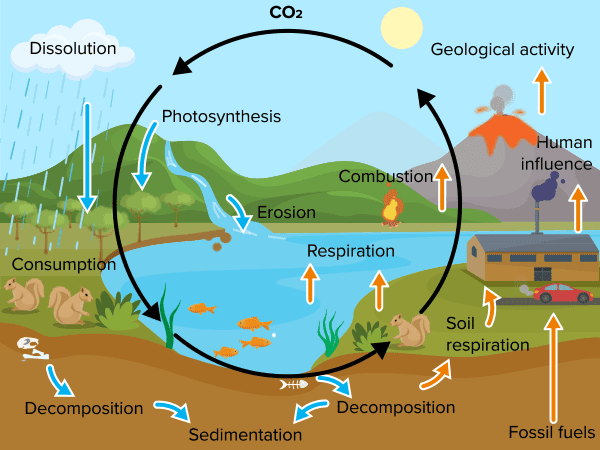
Exam Tip: Questions often ask you to explain the link between deforestation and climate change. Always mention both the loss of CO₂ absorption AND the release of stored carbon!
Pollution: When We Poison Our Own Home
Pollution is the introduction of harmful substances or products into the environment. Let’s explore the main types you need to know for your exam.
1. Air Pollution
Major air pollutants:
Carbon Monoxide (CO)
- Source: Incomplete combustion of fossil fuels (vehicles, factories)
- Effects: Combines with haemoglobin, reducing oxygen transport in blood
- Can be fatal in high concentrations
Carbon Dioxide (CO₂)
- Source: Burning fossil fuels, deforestation
- Effects: Main greenhouse gas contributing to global warming
- Natural part of atmosphere but increasing rapidly
Sulfur Dioxide (SO₂)
- Source: Burning fossil fuels containing sulfur (coal, oil)
- Effects: Causes acid rain, respiratory problems
- Damages stone buildings and vegetation
Nitrogen Oxides (NOₓ)
- Source: Vehicle exhausts, power stations
- Effects: Contributes to acid rain and photochemical smog
- Respiratory irritant
Methane (CH₄)
- Source: Cattle farming, rice paddies, landfills
- Effects: Powerful greenhouse gas (25× more effective than CO₂)
- Contributes significantly to climate change
Particulates
- Source: Diesel engines, industrial processes
- Effects: Respiratory diseases, reduced visibility
- Can carry toxic chemicals into lungs
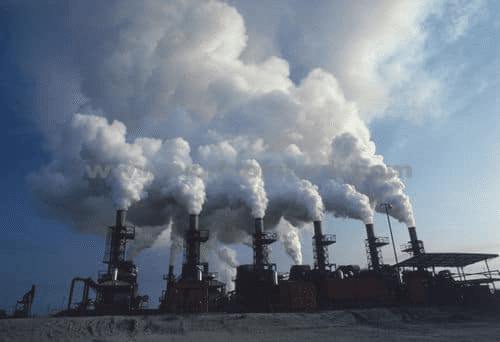
2. Water Pollution
Water pollution is a serious threat to aquatic ecosystems and human health. Here are the main culprits:
Sewage and Organic Waste
- Contains bacteria, viruses, and parasites
- Spreads waterborne diseases (cholera, typhoid)
- Leads to eutrophication (more on this soon!)
Chemical Pollutants
- Fertilizers and pesticides from agriculture
- Industrial chemicals and heavy metals
- Oil spills from tankers and offshore drilling
Plastic Pollution
- Non-biodegradable waste accumulating in oceans
- Microplastics entering food chains
- Physical harm to marine life (entanglement, ingestion)
Eutrophication: A Step-by-Step Disaster
This is a CRUCIAL process for your exam, so let’s break it down carefully:
Step 1: Excess Nutrients Enter Water
- Fertilizers run off from agricultural land
- Sewage enters water bodies
- Main culprits: nitrates and phosphates
Step 2: Algal Bloom
- Excess nutrients cause rapid algae growth
- Surface water becomes covered with algae
- Water looks green and murky
Step 3: Light Blockage
- Dense algae blocks sunlight
- Plants below surface can’t photosynthesize
- Underwater plants die
Step 4: Bacterial Decomposition
- Dead plants and algae sink to bottom
- Bacteria decompose organic matter
- Bacterial population explodes
Step 5: Oxygen Depletion
- Bacteria use up dissolved oxygen during aerobic respiration
- Oxygen levels drop dramatically
- Process called “deoxygenation”
Step 6: Death of Aquatic Life
- Fish and other organisms can’t get enough oxygen
- Mass die-offs occur
- Only anaerobic bacteria survive
- Water becomes foul-smelling and lifeless
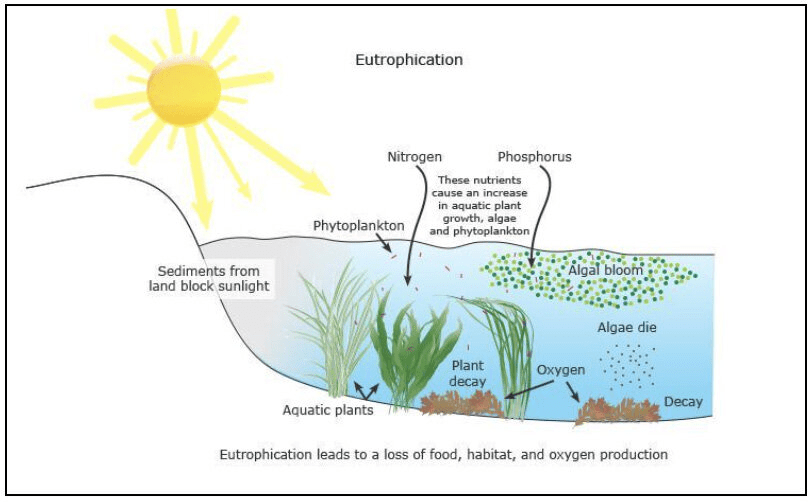
Memory Trick: “Nancy’s Algae Liked Blocking Deep Oceans” – Nutrients, Algae bloom, Light blocked, Bacterial growth, Death, Oxygen depletion!
3. Land Pollution
Main sources:
- Industrial waste dumping
- Agricultural chemicals
- Household waste in landfills
- Mining activities
Effects:
- Soil contamination
- Groundwater pollution
- Harm to soil organisms
- Reduced agricultural productivity
The Greenhouse Effect and Climate Change
Understanding the Greenhouse Effect
First, let’s be clear: the greenhouse effect is NATURAL and ESSENTIAL for life on Earth. Without it, our planet would be about -18°C on average-frozen solid!
How it works:
- Solar radiation reaches Earth
- Short-wave radiation from the Sun
- Passes through atmosphere easily
- Earth absorbs and re-radiates energy
- Earth’s surface warms up
- Re-radiates energy as long-wave infrared radiation
- Greenhouse gases trap heat
- CO₂, methane, water vapor, and nitrous oxide
- These gases absorb infrared radiation
- Re-radiate heat in all directions
- Some heat returns to Earth’s surface
- Result: Warmer planet
- Average global temperature: 15°C
- Perfect for supporting life
The Enhanced Greenhouse Effect: Too Much of a Good Thing
The problem isn’t the greenhouse effect itself-it’s that human activities are enhancing it beyond natural levels.
Main greenhouse gases and their sources:
| Gas | Human Sources | Relative Impact |
|---|---|---|
| Carbon dioxide (CO₂) | Fossil fuel combustion, deforestation | Most significant due to quantity |
| Methane (CH₄) | Agriculture (cattle, rice), landfills | 25× more potent than CO₂ |
| Nitrous oxide (N₂O) | Agricultural fertilizers, industrial processes | 300× more potent than CO₂ |
| CFCs | Refrigerants, aerosols (now banned) | Thousands of times more potent |
Consequences of climate change:
- Rising global temperatures
- Average increase of 1.1°C since pre-industrial times
- Projected increase of 1.5-4.5°C by 2100
- Ice cap and glacier melting
- Loss of polar habitats
- Rising sea levels
- Threatens coastal communities
- Sea level rise
- Flooding of low-lying areas
- Loss of coastal ecosystems
- Displacement of millions of people
- Extreme weather events
- More frequent and severe hurricanes
- Extended droughts
- Intense heatwaves and cold snaps
- Unpredictable rainfall patterns
- Ecosystem disruption
- Species migration patterns changing
- Coral reef bleaching
- Shifts in growing seasons
- Increased extinction rates
- Ocean acidification
- CO₂ dissolves in seawater forming carbonic acid
- Threatens shell-forming organisms
- Disrupts marine food chains
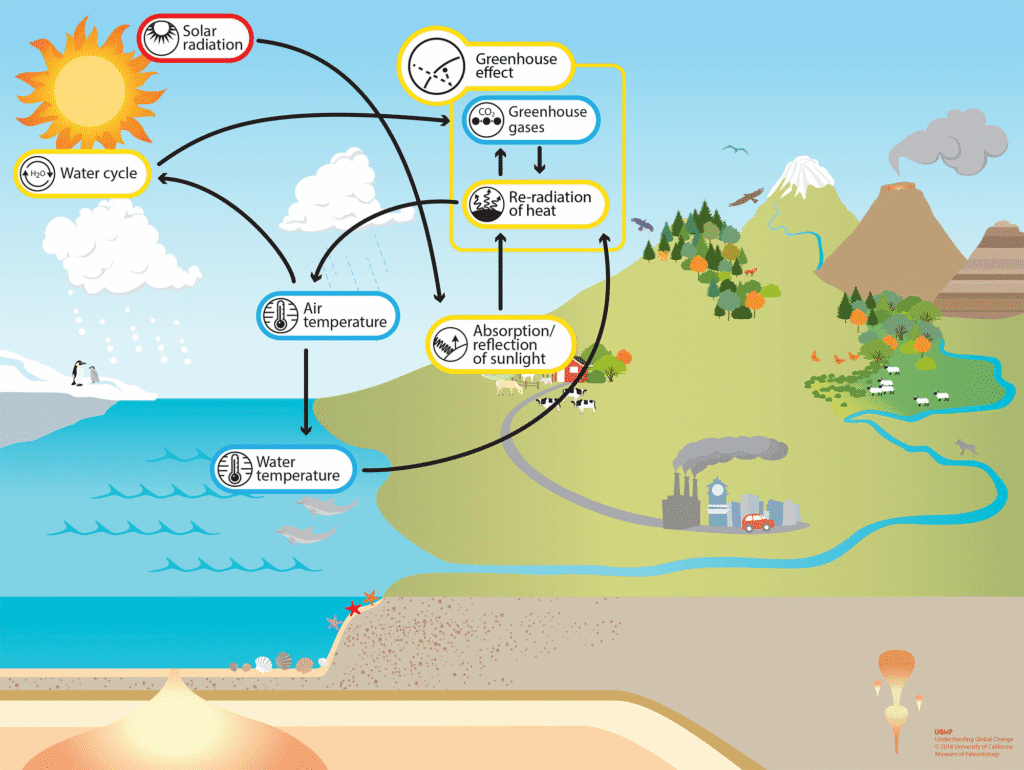
Conservation and Sustainable Development: Hope for the Future
Now for the good news-we can do something about it! Let’s look at positive actions being taken worldwide.
What Is Conservation?
Conservation is the protection and management of natural resources and ecosystems to prevent their degradation or extinction. It’s about using resources wisely so they’ll be available for future generations.
Conservation Methods
1. Protected Areas
- National parks and nature reserves
- Marine protected areas
- Wildlife corridors connecting habitats
- UNESCO World Heritage Sites
2. Breeding Programs
- Captive breeding of endangered species
- Artificial insemination techniques
- Genetic diversity management
- Reintroduction to wild habitats
3. Legal Protection
- Hunting and trade bans (CITES agreement)
- Fishing quotas and size limits
- Protected species legislation
- Habitat protection laws
4. Habitat Restoration
- Reforestation and afforestation projects
- Wetland restoration
- Coral reef restoration
- Removing invasive species
5. Education and Awareness
- Public education programs
- Ecotourism promoting conservation
- Community involvement in protection
- Scientific research and monitoring
Sustainable Development: Meeting Today’s Needs Without Compromising Tomorrow
Sustainable development means meeting the needs of the present without compromising the ability of future generations to meet their own needs.
Key principles:
- Economic growth that doesn’t harm the environment
- Social equity and improved quality of life
- Environmental protection and resource conservation
Examples of sustainable practices:
Sustainable Fishing:
- Setting catch quotas based on scientific data
- Protecting breeding grounds
- Using selective fishing methods
- Avoiding bycatch of non-target species
- Allowing fish populations to recover
Sustainable Forestry:
- Selective logging instead of clear-cutting
- Replanting trees after harvesting
- Protecting old-growth forests
- Maintaining biodiversity corridors
- Certifying sustainable timber (FSC label)
Sustainable Agriculture:
- Crop rotation to maintain soil fertility
- Organic farming reducing chemical use
- Integrated pest management
- Conservation tillage
- Agroforestry combining trees and crops
Renewable Energy:
- Solar power
- Wind energy
- Hydroelectric power
- Geothermal energy
- Biomass and biofuels
Waste Management:
- Reduce, Reuse, Recycle (the 3 Rs)
- Composting organic waste
- Better landfill management
- Waste-to-energy programs
- Reducing single-use plastics
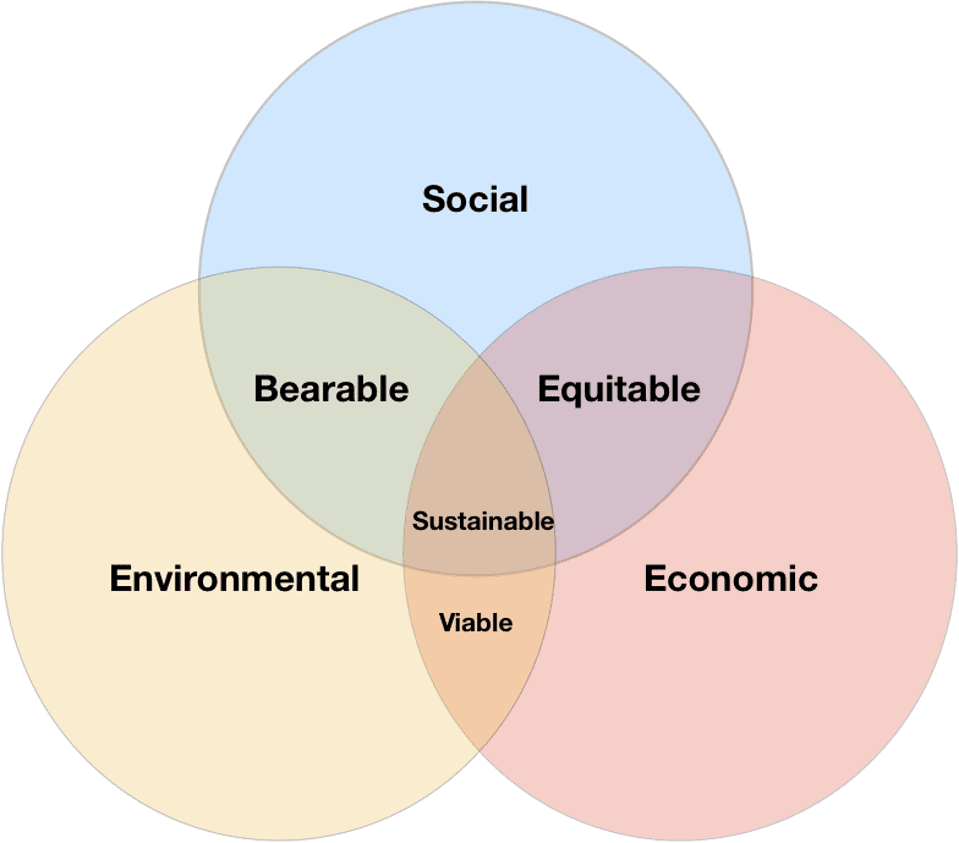
International Cooperation
Major agreements:
- Paris Agreement (2015): Limiting global warming to well below 2°C
- Convention on Biological Diversity: Protecting species and ecosystems
- CITES: Regulating trade in endangered species
- Montreal Protocol: Phasing out ozone-depleting substances
Reducing Our Impact: Practical Solutions
For Governments and Industries
Reducing air pollution:
- Catalytic converters in vehicles (convert CO and NOₓ to less harmful gases)
- Scrubbers in power station chimneys (remove SO₂)
- Stricter emission standards
- Investment in public transportation
- Transition to electric vehicles
Reducing water pollution:
- Sewage treatment plants
- Stricter regulations on industrial discharge
- Monitoring water quality
- Penalties for polluters
- Wetland protection (natural filtration)
Combating climate change:
- Carbon taxes and trading schemes
- Investing in renewable energy
- Phasing out coal power plants
- Energy efficiency standards
- Carbon capture and storage technology
What You Can Do: Individual Actions Matter
Reduce your carbon footprint:
- Walk, cycle, or use public transport
- Reduce meat consumption (especially beef)
- Choose local, seasonal produce
- Reduce, reuse, recycle
- Turn off lights and appliances
- Use energy-efficient products
Conserve water:
- Take shorter showers
- Fix leaky taps
- Don’t leave water running
- Use water-efficient appliances
Reduce waste:
- Avoid single-use plastics
- Bring reusable bags, bottles, and cups
- Compost organic waste
- Buy products with minimal packaging
- Repair instead of replace
Support conservation:
- Choose sustainable products (FSC timber, MSC fish)
- Support conservation organizations
- Participate in local clean-up events
- Spread awareness among friends and family
Remember: Individual actions might seem small, but 8 billion small actions add up to massive change!
Common Mistakes to Avoid (Exam Tips!)
- Confusing the greenhouse effect with ozone depletion
- These are TWO DIFFERENT issues!
- Greenhouse effect = climate change
- Ozone depletion = CFCs damaging ozone layer
- Forgetting that greenhouse effect is natural and necessary
- Don’t write that we need to “stop the greenhouse effect”
- We need to reduce the ENHANCED greenhouse effect
- Incomplete eutrophication explanations
- Don’t just say “algae grow and fish die”
- You MUST mention: nutrients → algae bloom → light blocked → plants die → bacteria decompose → oxygen depletion → fish die
- Not being specific about pollutants
- Don’t just write “pollution is bad”
- Name specific pollutants and their effects
- Forgetting to mention both causes AND consequences
- Exam questions often ask for BOTH
- Practice linking human activities to their impacts
- Mixing up conservation and preservation
- Conservation = sustainable use of resources
- Preservation = complete protection, no use
Quick Revision Notes
Key Definitions
Deforestation: The permanent removal of forests and trees to use land for other purposes.
Pollution: The addition of substances to the environment that harm living organisms.
Eutrophication: The excessive enrichment of water bodies with nutrients, leading to algal blooms and oxygen depletion.
Greenhouse effect: The trapping of heat by gases in the atmosphere, warming the Earth’s surface.
Climate change: Long-term changes in global temperature and weather patterns, primarily caused by human activities.
Conservation: The protection and management of ecosystems and species to ensure their survival.
Sustainable development: Development that meets present needs without compromising future generations’ ability to meet their needs.
Biodiversity: The variety of different species and ecosystems in a particular area or on Earth.
The Eutrophication Process (Memorize This!)
- Excess nutrients (nitrates/phosphates) enter water
- Algal bloom occurs (rapid algae growth)
- Light is blocked to underwater plants
- Underwater plants die
- Bacteria decompose dead organic matter
- Bacteria use oxygen in aerobic respiration
- Oxygen levels drop (deoxygenation)
- Fish and aerobic organisms die
Major Air Pollutants Summary
| Pollutant | Source | Main Effect |
|---|---|---|
| CO₂ | Fossil fuels | Greenhouse gas |
| CO | Incomplete combustion | Toxic to humans |
| SO₂ | Burning coal/oil | Acid rain |
| NOₓ | Vehicle exhausts | Acid rain, smog |
| CH₄ | Agriculture, landfills | Greenhouse gas |
| Particulates | Diesel, industry | Respiratory issues |
Consequences of Deforestation (The Big Five)
- Increased CO₂ (fewer trees absorbing it)
- Soil erosion (no roots holding soil)
- Loss of biodiversity (habitat destruction)
- Disrupted water cycle (less transpiration)
- Climate change (carbon release + reduced absorption)
Conservation Methods (Quick List)
- Protected areas (national parks, reserves)
- Breeding programs (captive breeding, reintroduction)
- Legal protection (hunting bans, CITES)
- Habitat restoration (reforestation, rewilding)
- Education and awareness
- Sustainable resource use
- International cooperation
Important Exam Questions to Practice
Short Answer Questions (2-4 marks)
- State two sources of water pollution. (2)
- Explain why carbon monoxide is dangerous to humans. (2)
- List three greenhouse gases. (3)
- Define the term ‘sustainable development’. (2)
- State two ways in which individuals can reduce their carbon footprint. (2)
Structured Questions (5-8 marks)
- Describe and explain the process of eutrophication. (6)
- This is a classic exam question! Make sure you know all the steps.
- Explain how deforestation contributes to climate change. (4)
- Hint: Mention both loss of CO₂ absorption AND carbon release
- Describe three negative effects of increasing human population on the environment. (6)
- Explain how sulfur dioxide causes acid rain and describe its effects. (5)
- Describe two methods of conserving endangered species. (4)
Extended Response Questions (8-10 marks)
- Discuss the causes and consequences of climate change, and suggest ways in which its effects can be reduced. (10)
- Describe the problems caused by deforestation and explain how sustainable forestry can help address these problems. (8)
- Explain how human activities cause water pollution and describe methods to reduce it. (8)
Exam Technique Tips
For “Describe” questions:
- Give detailed facts and characteristics
- Use proper scientific terminology
- Provide specific examples
For “Explain” questions:
- Don’t just state facts-say WHY or HOW
- Use linking words: “because,” “therefore,” “as a result”
- Show cause-and-effect relationships
For “Suggest” questions:
- Use your knowledge to propose solutions
- Be realistic and practical
- Explain why your suggestion would work
For longer questions:
- Plan your answer before writing
- Use paragraphs for different points
- Check you’ve covered all parts of the question
- Leave time to review your answer
Key Equations and Processes Box
Combustion Reactions (Sources of Pollution)
Complete combustion of fossil fuels:
Hydrocarbon + Oxygen → Carbon dioxide + Water
Example: CH₄ + 2O₂ → CO₂ + 2H₂OIncomplete combustion:
Hydrocarbon + Oxygen → Carbon monoxide + Water
Example: 2CH₄ + 3O₂ → 2CO + 4H₂OAcid Rain Formation
Sulfur dioxide reaction:
SO₂ + H₂O → H₂SO₃ (sulfurous acid)
2H₂SO₃ + O₂ → 2H₂SO₄ (sulfuric acid)Nitrogen oxide reaction:
NO₂ + H₂O → HNO₃ (nitric acid)Photosynthesis (Why trees matter for CO₂)
6CO₂ + 6H₂O → C₆H₁₂O₆ + 6O₂
(Carbon dioxide + Water → Glucose + Oxygen)Aerobic Respiration (Why eutrophication depletes oxygen)
C₆H₁₂O₆ + 6O₂ → 6CO₂ + 6H₂O + Energy
(Glucose + Oxygen → Carbon dioxide + Water + Energy)Test Yourself: Quick Check Questions
Try these without looking back at your notes!
- Name three greenhouse gases.
- What is the main cause of eutrophication?
- Why is carbon monoxide dangerous?
- List two consequences of deforestation.
- What does CITES stand for, and what is its purpose?
- Explain in one sentence what sustainable development means.
- What happens to sulfur dioxide in the atmosphere to create acid rain?
- Name two renewable energy sources.
- Why do fish die during eutrophication?
- What is the difference between conservation and preservation?
Answers:
- CO₂, CH₄, N₂O (also water vapor, CFCs)
- Excess nutrients (nitrates/phosphates) from fertilizer runoff or sewage
- It binds to hemoglobin, preventing oxygen transport in blood
- Any two: Increased CO₂, soil erosion, biodiversity loss, disrupted water cycle, climate change
- Convention on International Trade in Endangered Species; regulates/bans trade in endangered species
- Meeting present needs without compromising future generations’ ability to meet their needs
- SO₂ dissolves in rainwater forming sulfurous/sulfuric acid
- Any two: Solar, wind, hydroelectric, geothermal, biomass
- Bacteria decomposing dead organic matter use up oxygen in aerobic respiration
- Conservation = sustainable use; Preservation = complete protection with no use
How did you do?
- 8-10 correct: Excellent! You’re ready for the exam!
- 5-7 correct: Good foundation, review the topics you missed
- 0-4 correct: Go back through the guide and make notes on key points
Final Words: You’ve Got This!
Congratulations on making it through this comprehensive guide! Topic 20 might seem overwhelming at first-there’s a lot to take in, from eutrophication to the enhanced greenhouse effect, from deforestation to sustainable development. But here’s the thing: this topic is incredibly relevant to your life right now and your future.
Study Tips for Success:
- Make visual aids: Draw out the eutrophication process, the carbon cycle, and the greenhouse effect. Visual memory is powerful!
- Use active recall: Don’t just re-read your notes. Test yourself regularly using the questions in this guide.
- Teach someone else: Explain topics to a friend, family member, or even your pet! Teaching forces you to truly understand.
- Create flashcards: Make cards for key definitions, pollutants, and processes. Review them daily.
- Practice past papers: Exam questions follow patterns. The more you practice, the more confident you’ll become.
- Link to real news: When you hear about climate conferences, pollution incidents, or conservation successes in the news, connect them to what you’re learning. It makes the content memorable and meaningful.
Remember: This topic isn’t just about passing an exam-it’s about understanding your relationship with the planet and your power to make a difference. Every choice you make, from what you eat to how you travel, has an impact. Knowledge is the first step to positive change.
Before Your Exam:
- Review the Quick Revision Notes section
- Practice the Important Exam Questions
- Draw out key processes from memory
- Review common mistakes to avoid
- Get a good night’s sleep!
Related Topics to Explore:
- Topic 19: Organisms and their environment
- Topic 18: Variation and selection
- Topic 5: Enzymes (links to decomposition in eutrophication)
- Topic 6: Plant nutrition (photosynthesis and CO₂ absorption)
You’re now equipped with everything you need to excel in this topic. Trust in the work you’ve put in, stay calm during the exam, and remember-you’re part of a generation that will shape the future of our planet.
Recommended –

